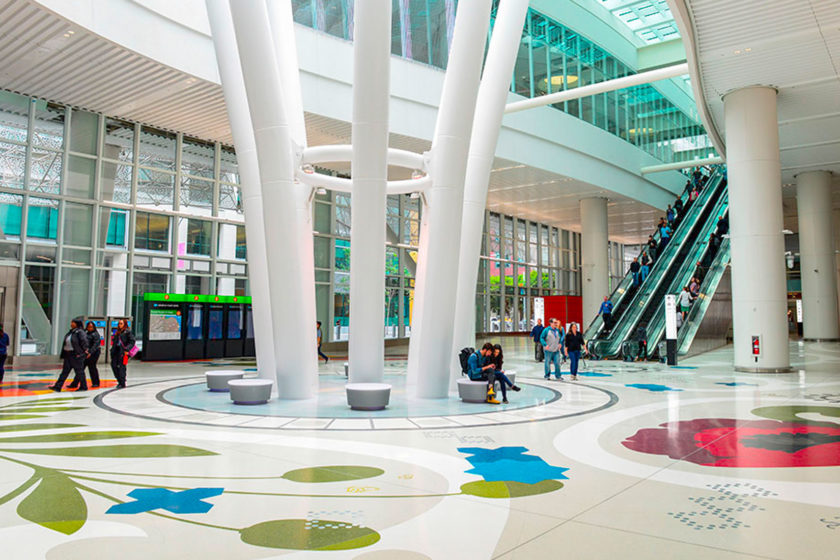The Experts Weigh In
General contractors or designers regularly call Leslie Carrio, president of DePaoli Mosaic, a terrazzo contractor in Boston, during the preparation phases of a construction project.
Confusion in the ranks
They may ask her for technical advice on using terrazzo or for budget figures. A traditional terrazzo contractor, Ms. Carrio’s company has been installing terrazzo since 1890. They offer only traditional terrazzo, which includes several standard floor systems, all poured in place on the job site. About once a week, though, Ms. Carrio reports that her company may be invited to bid to do a job that “telltale signs” show her falls outside what they do.
In continued conversation with these potential clients, Ms. Carrio said she sometimes notes listed in the specs a manufacturer’s name, for example, one that offers what some call “faux terrazzo” products.
Another clue that what the GC or designer is talking about is not traditional terrazzo is when they send her a sample of the “terrazzo” product they are interested in having her company install. Or the installation procedures in the specs may include instructions to “bring in the tiles to let them acclimate.”
“It’s an educational opportunity for me,” Ms. Carrio said. “There is a lot of confusion. Sometimes a sales rep has come in and talked about his ‘terrazzo line,’ and the people calling me may not have taken the time to investigate the physical characteristics of the actual floor being proposed.”
You’ve got the look
The consensus is that the popularity of the terrazzo look is what seems to be driving this situation. Designers and end users like terrazzo’s chip pattern, and may use the term to refer to the pattern the way we use words such as “paisley” or “plaid,” rather than to the material itself. Imitators see an opportunity to meet the demand for a floor that looks like terrazzo, thus turning terrazzo—and possibly those who may not be paying attention—into a victim of its own good looks. But is traditional terrazzo more than just another pretty floor?

“Beyond Rainbow’s End” is artist-designed epoxy terrazzo floor at Fort Lauderdale-Hollywood International Airport’s Concourse E that displays brass starfish scattered across a beach-like surface.

At Wichita Dwight D. Eisenhower National Airport, over 50,000 hand-set zinc strips trace the journey of flight across 100,000 square feet of earth-toned epoxy terrazzo.
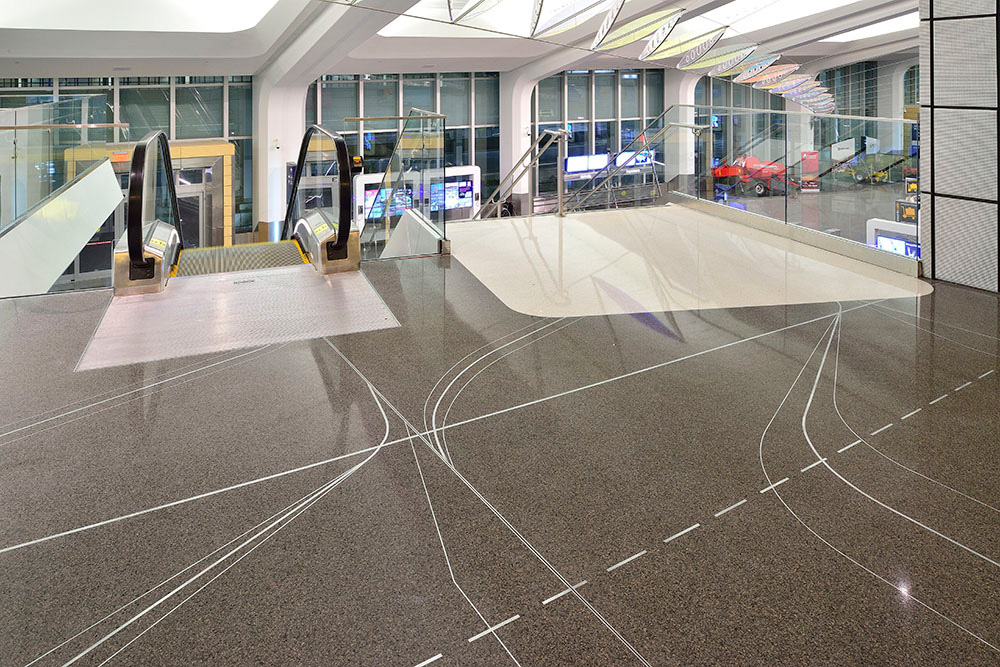
This striking epoxy terrazzo installation at Wichita’s Eisenhower Airport celebrates aviation through a flowing, 3-D design of zinc strip pathways.
Terrazzo has been from its beginnings in the Old World a flooring material, like wood or linoleum, or tile. The name is not trademarked or even capitalized, for that reason. Terrazzo is not a legally protected brand; the name is neither owned nor manufactured by a particular company. No one company can lay claim to the name, which means that anybody can.
Traditional terrazzo, defined not by its appearance but by its physical characteristics, is a flooring system poured in place on-site by trained craftsmen, not manufactured in a factory and brought to the site for installation. Terrazzo can consist of marble, quartz, granite aggregate, mother-of-pearl and/or pre-consumer and post-consumer recycled glass, porcelain, and mirror chips, which are mixed with cement or epoxy and polished. It’s composed of durable materials, producing a permanent, dense, non-porous, and uniformly textured surface for floors. It can also clad walls, seating surfaces, countertops, or even ceilings.
Ms. Carrio compares the faux terrazzo industry’s appearance on the construction scene to the evolution of the wood flooring industry. Engineered floors that imitate wood have been developed, some higher quality than others.
“People might ask ‘What kind of wood floor are you getting?’ and the answer might be ‘Pergo.’” she explained. To those looking specifically for a certain general style at a low cost, the product details may seem to have little importance.
“The bad thing for terrazzo industry is when someone has a faux terrazzo floor and it only lasts 10 years, and they say, ‘Oh, I had a terrazzo floor, it wasn’t that great.’ Well, no, you didn’t have a terrazzo floor; you had something that someone called terrazzo,” Ms. Carrio said.
If it looks like terrazzo…

Close inspection reveals bumpy texture and an obvious seam in the faux terrazzo installation.
A senior consultant to the terrazzo industry, Fritz Iselin of Niagara Research, gave an overview of some “other light duty options that may look like and might be called terrazzo.”
Flake or chip floors are engineered products, basically resilient flooring in the category of VCT, sheet goods or squares that adhere to the substrate. These products are generally installed by VCT contractors.
Also available are DIY products referred to as “terrazzo kits.” They are composed of epoxy to be applied like paint with a roller and decorative paint chips or flakes of acrylic or vinyl that are broadcast to approximate the look of aggregate. A clear finish coat polyurethane is then applied.
Prefab terrazzo
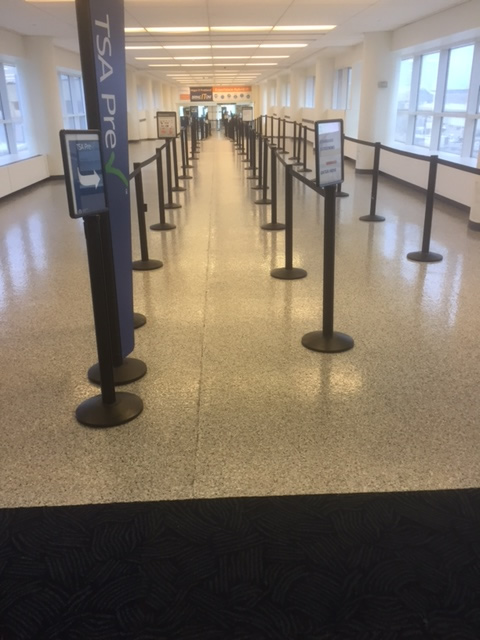
The faux terrazzo surface appears uneven underfoot.
“Prefabricated terrazzo tiles are about halfway between flake floors and jobsite-installed terrazzo,” Mr. Iselin said. Installed by hard tile contractors, terrazzo tiles are 3/16 to 5/16-inch thick.
Large factory-produced panels, 5×10 feet and 1/4 inch thick, also install like tile. The larger format means fewer joints in the floor than tile, without grinding or finishing. The panels are fragile like a pane of glass and are installed on a perfectly flat concrete floor, Mr. Iselin noted.
“There’s a place for them,” he said. “They are functional, and appropriate for some renovations projects.”
Your best option for the look you want to achieve will depend on the application, the durability and design requirements of the project, and of course, the budget.
Check out the physical characteristics
“Just because someone calls it terrazzo, doesn’t mean it shares the physical properties and longevity of terrazzo,” stated Ms. Carrio. “Longevity is the main issue: terrazzo can be expected to last 75-100 years.”
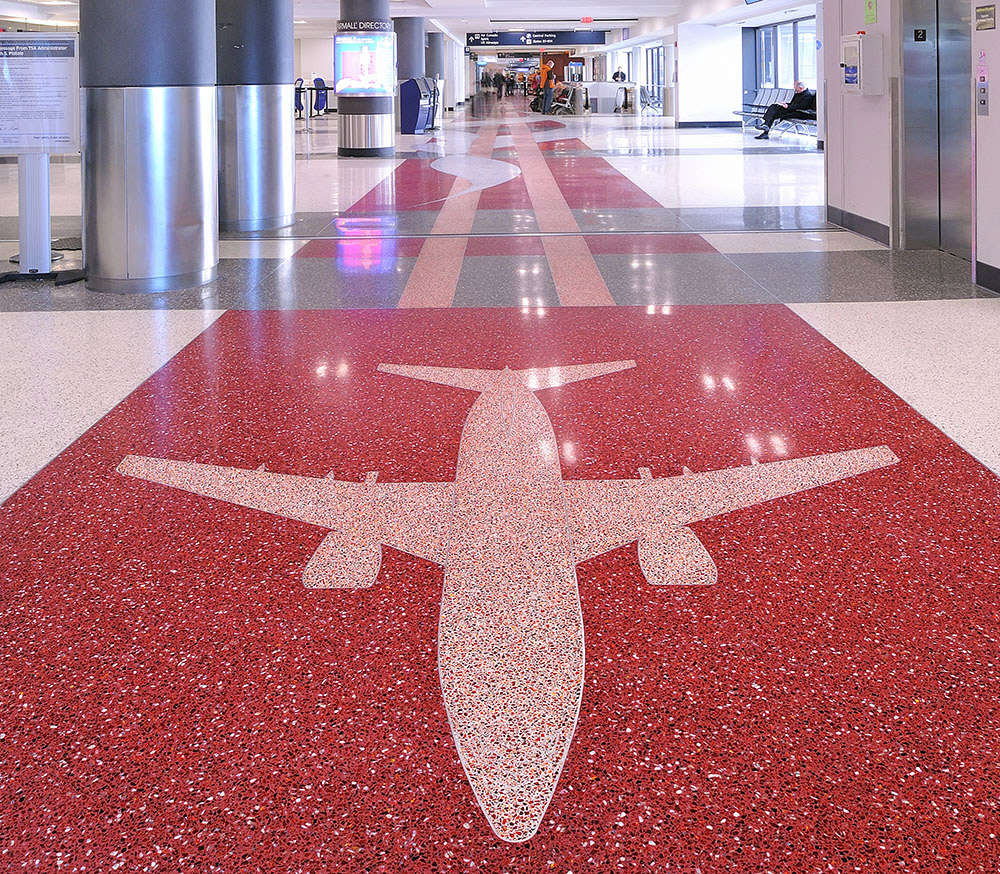
In Boston’s Logan Airport are numerous durable and beautiful epoxy terrazzo floors installed by DePaoli Mosaic, one of the oldest terrazzo companies in the United States.
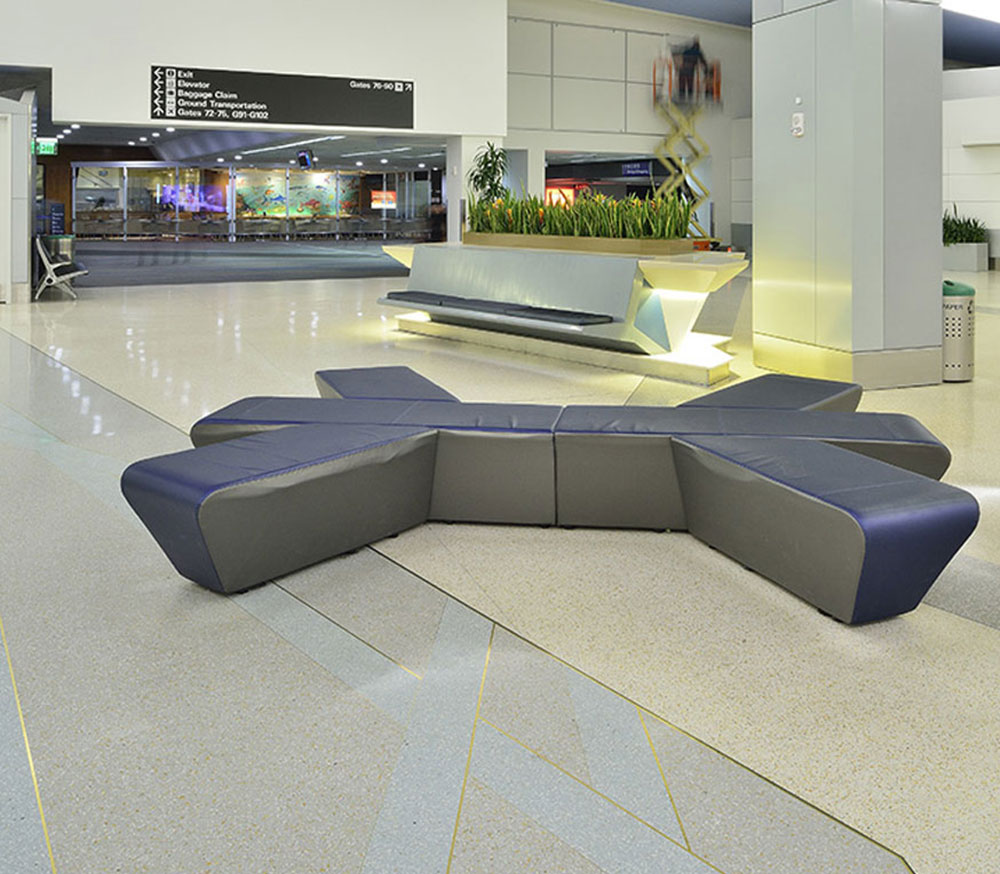
This epoxy terrazzo installation in San Francisco |nternational Airport creates a soothing, elegant space for travelers.
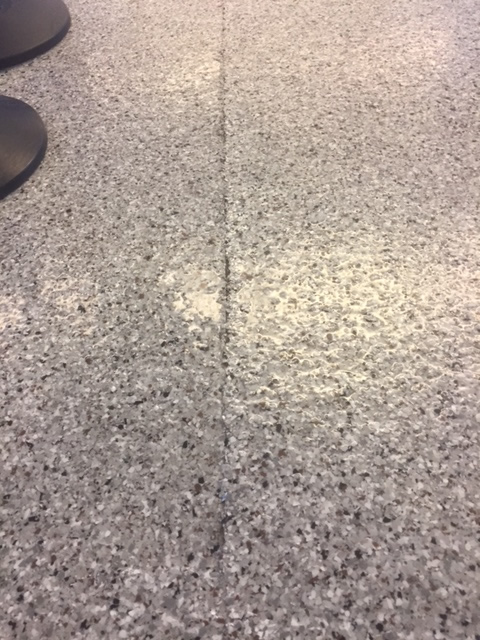
Faux terrazzo in this concourse shows visible seams and surface irregularities.
“Longevity is a direct result of thickness,” Mr. Iselin explained. “The sheer amount of materials to resist wear and tear is a major advantage of traditional terrazzo.”
The resilient products, flake or chip floors, are a maximum of 1/16-inch thick and offer considerably less wear than traditional terrazzo. We can’t expect the same type of wear from a thinner floor as from traditional terrazzo, which can be refinished and restored to look as good as new again, over the span of decades.
Sand cushion cement terrazzo floors are 2.5 to 3 inches thick, including the half-inch terrazzo topping. It weighs in at 25-30 pounds per square foot. The most frequently installed terrazzo system, 3/8-inch thin-set epoxy, weighs 3-4 pounds per square foot. Traditional terrazzo comes in a wide range of standard systems designed for a variety of uses, including an unpolished rustic finish for outdoor use. The prices vary significantly and also depend on the complexity of the design and colors.
“With faux terrazzo, the only real advantage I can see is upfront costs,” Ms. Carrio said. “If you use sprinkled chips or flakes and get enough traffic, it will wear out. You see that in a brewpub in the hall to the bathroom where everyone walks: the color is worn off. Paint chips are not rocks.”
Among other advantages of traditional terrazzo is a lack of grout lines and joints. A smooth floor means less noise when suitcases and gurneys are part of the traffic. It also makes for a cleaner, antimicrobial surface, which is essential for healthcare facilities, for example, she added.
“It all depends on the application. Sometimes those newer, lower-cost options are just what people do want,” Ms. Carrio concluded. “If you don’t care about the life cycle and want something cheap, it might be just the right thing.”
What are the real costs?
In considering the growing list of options that offer the multicolor, textured look of terrazzo, keep in mind that time always equals money, both in the short term and the long term. During the life of a building, the total cost of flooring can amount to 35 times the initial installed cost. Taking into account regular maintenance and replacement costs will give a more accurate total price.
Installing large, factory-made terrazzo panels cuts in half the time that’s needed to put in traditional terrazzo, but net cost is about the same, Mr. Iselin reported. Smaller terrazzo tiles install like normal ceramic tiles.
“The appeal of the cheaper, faster, simpler options is you don’t need a skilled terrazzo contractor, special equipment, and the added time and mess,” he explained. “It can be a substantial investment.
“Faux terrazzo can be installed in three days, but it’s not nearly equal quality; it offers a much lower performance,” Mr. Iselin said. Quicker means cheaper in the short run, but the right upfront investment can bring considerable ROI for a building meant to least more than a few years.
Daily and over many years, time, money and effort are also recuperated through the ultra-streamlined maintenance requirements of traditional terrazzo.
A sealer is recommended, then a terrazzo floor generally needs only a daily dust mopping and a weekly damp mop with a neutral cleaner. Depending on traffic, an occasional buff and reseal will keep the floor looking as good as the day it was installed, for a lifetime. The lower-quality terrazzo alternatives generally can require regular waxing and frequent total replacements.
Demanding Designs?
When designing a truly custom floor is a priority, either fake or pre-fab terrazzo is probably a mistake. The apparently endless design potential of traditional terrazzo allows designers to realize whatever look they envision. Traditional terrazzo allows for a seamless look, but also offers endless options for creatively applied divider strips or design elements in water-jet-cut zinc or brass to be incorporated in the design.
Debra Babcock, Director of Interiors with Chesney Morales Architects/Planners & Associates in San Antonio, advises designers to be fully informed and to guide their clients in choosing the best of the many options for the look they want.
“While the prefab terrazzo is sold to be more convenient and less time intensive for the construction process, young designers do need to know that they are limiting themselves design wise and not providing their clients with a more durable, long lasting surface for about the same cost,” she said.
Cost counts, but the cheapest option may well turn out not to be the least costly, all factors considered
“Cement or epoxy terrazzo is still top drawer, the Cadillac, the best-recognized quality,” said Mr. Iselin.
“‘Cast-in-place can be competitive,’ as I always tell people who ask me for faux terrazzo,” Ms. Carrio stated. “The main piece of advice I give them is: ‘Why get fake terrazzo when you can get the real thing?”
Advantages of Traditional Terrazzo
- Durability
- Custom design flexibility
- Seamless
- Best life cycle cost
- Ease of maintenance





